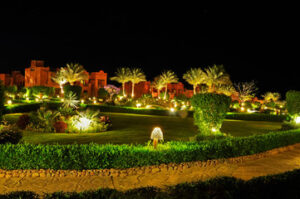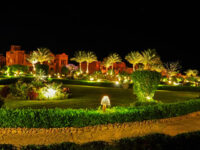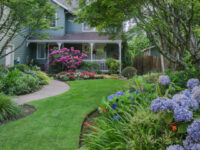Landscape Lighting – Creating a Captivating Wonderland at Night
Landscape Lighting Orlando, FL transforms your home into a captivating wonderland at night. Well-placed fixtures create a stunning glow that enhances your favorite features while improving safety and security.
Begin with a thorough property survey to identify underground cables, pipes, and irrigation lines. Choose a trenching shovel with a narrow blade to minimize soil disturbance.
When constructing a landscape lighting system, the materials used to construct your fixtures and wiring are vitally important. The choices you make will impact your lighting design, energy consumption, and overall cost. Investing in high-quality material options will ensure your system functions effectively and looks its best.
The material choice you select will depend on your budget, style preference, and the durability requirements of your installation. Plastics, for instance, are inexpensive, light in weight, and molded into many different shapes and sizes. However, they are vulnerable to UV exposure and can degrade with frequent use or harsh weather conditions.
Metal options are a step up in quality and durability from plastics, offering superior strength and resistance to corrosion. Copper, for example, is a premium choice and naturally resistant to the elements. Unlike brass, copper will develop a beautiful patina over time and is a great option for coastal areas where salt spray accelerates corrosion.
Stainless steel is another premium material that offers strength and sleek aesthetics. This durable steel is chromium-rich, which helps it resist corrosion and oxidation from extreme temperatures and environments. Aluminum, on the other hand, is lightweight and highly workable, making it a popular construction choice for outdoor lighting fixtures and wires. This versatile material is less expensive than brass and copper but can still stand up to the elements and corrosion.
When choosing a wire for your landscape lighting system, you’ll need to consider its gauge size, carrying capacity, and distance. A landscape lighting professional will help you determine what type of wire you need for your project, and then recommend a specific gauge to match your installation needs. Wires are also available in a range of finishes and configurations that enhance durability and versatility.
Choosing the right wire for your lighting project will ensure that it performs well and complements your landscape. High-quality wires are engineered with climate and installation challenges in mind. Premium finishes and flexible configurations are designed to withstand various outdoor environments, while providing the flexibility necessary for efficient operation and installation. Wire insulation is typically made from UV-resistant materials to protect it from sunlight, which can degrade the material over time.
Bulbs
When designing a lighting scheme, choosing the right bulbs is crucial. Not all light bulbs are created equal, and it’s important to select ones that are UL rated for outdoor use. Energy efficiency, lumens and lux ratings are also important considerations. Prioritizing energy-efficient bulbs will reduce your electricity bills and help you to save on maintenance costs.
LED bulbs are a popular choice for landscape lighting because they consume up to 90% less energy than traditional incandescent and CFL bulbs. They also have a long lifespan, reducing the frequency of replacements and contributing to cost savings. In addition, LED bulbs produce a bright, pure white light, ideal for accenting trees or other focal points.
Halogen bulbs are another option that offers many of the same benefits as LED bulbs. They are affordable and offer a warm, inviting glow that works well for path lights or to highlight garden statues or other architectural features. In addition, halogen bulbs can be dimmed, giving you the flexibility to create a range of moods for your outdoor lighting scheme.
Other bulb types to consider include MR (multi-faceted reflector) and PAR (parallel array) bulbs. MR and PAR bulbs produce a narrower beam of light, making them suitable for spot lighting or to highlight particular plant species or features within your yard. Unlike LEDs, these bulbs do not produce any heat and require special fixtures to keep them safe from overheating.
Finally, BR30 and BR40 bulbs are popular choices for patio wall sconces and other decorative outdoor lighting fixtures. These bulbs produce a warm, soft light and are suitable for creating a cozy atmosphere around dining areas or seating spaces. In addition, they are easy to find and are inexpensive.
Regardless of the type of bulbs you choose, it’s essential to pair them with durable, weather-resistant fixture options. A reputable landscape lighting company like Volt Lighting will be able to provide you with a wide selection of both styles and brightness levels, ensuring that you can find the perfect match for your space. They’ll also make sure that your new lighting design is properly oriented to avoid any safety hazards.
Fixtures
There are many different types of landscape lighting fixtures to choose from. They can vary in shape, style, and brightness. Some of the most popular include:
There are also a variety of bulb types available for landscape lighting. These include halogen, fluorescent, and LED bulbs. The latter are the most popular because they last longer and use 15-20 percent less electricity than halogen bulbs. They also come in a range of colors.
The design of the lighting system is important for the aesthetics of your home and yard. The best way to determine your landscape lighting needs is to walk around the property at night and compare how things look to how they appear during the day. This will help you see where additional lights are needed.
Adding light to your outdoor living spaces will enhance the architectural features of your home and make it stand out from the surrounding homes. It can also create a magical atmosphere that will be the envy of the neighborhood. A well-planned lighting scheme will increase the value of your home and make it more appealing to prospective buyers.
When you are choosing lighting for your landscape, it is a good idea to work with an experienced landscape lighting professional. These specialists are familiar with the different fixtures and know how to connect them for the most attractive effects. They can also help you choose the right lights and bulbs for your landscape.
Using motion sensor lights can improve dark sky compliance and reduce energy costs by activating only when there is movement near the fixture. This will prevent unnecessary illumination and minimize light trespass into neighboring areas. Decorative bollard lights are also a great choice for highlighting walkways or other features of your landscape.
A low-voltage landscape lighting system typically consists of a transformer, low-voltage cable, and light fixtures. The transformer converts standard 120-volt household current to a safe 12 volts for the light fixtures. The cable runs between the transformer and the fixtures. The fixtures are placed where they will illuminate specific areas of your landscape and can be controlled from a convenient control box or through a smart device.
Finishes
Landscape lighting adds safety and ambiance to outdoor spaces by illuminating walkways, stairs, patios, outdoor seating areas, driveways and entryways. It also highlights the unique design elements of a yard and makes it easier to enjoy gardens, flowers and trees after dark. It can make your home more attractive during the day, too.
Many homeowners choose to use low-voltage landscape lights in their yards. This system uses a transformer to step down the voltage of standard household power, then distributes it to each fixture through cables. The lighting is controlled by timers, hardwired switches or keypads. The bulbs come in a variety of colors, beam widths and brightnesses, but most are LED which save energy and last longer than halogen bulbs.
The fixture finish is another important choice to consider. Painted aluminum is the most popular option because it blends in well with most color schemes, but it can be compromised by harsh weather conditions like salt spray or chemicals that are used to maintain your landscape. Brass fixtures have no painted surface and withstand these harsh conditions better than their aluminum counterparts. Stainless steel fixtures are also available for contemporary homes and blend in well with darker colored / stained decks, structures and natural stone.
Some fixture finishes are designed to disappear into the landscape during the day so that you only see the light beams at night. Others are meant to stand out. For example, climbing ivy and tall bushes are best illuminated with the grazing technique that uses a beam no more than 12 inches wide to focus on the foliage or structure.
Copper and Brass are a wise choice for the outdoor environment because they are naturally resistant to oxidation. This is why these metals were once used in a multitude of applications where it was vital that they function no matter what the surroundings were like. The copper and brass finishes available from are matte bronze, verde (green patina), aged brass or moss to create a look that will age gracefully in the garden. Other finishes include rust, oil rubbed bronze and raw brass to achieve a more industrial style.






